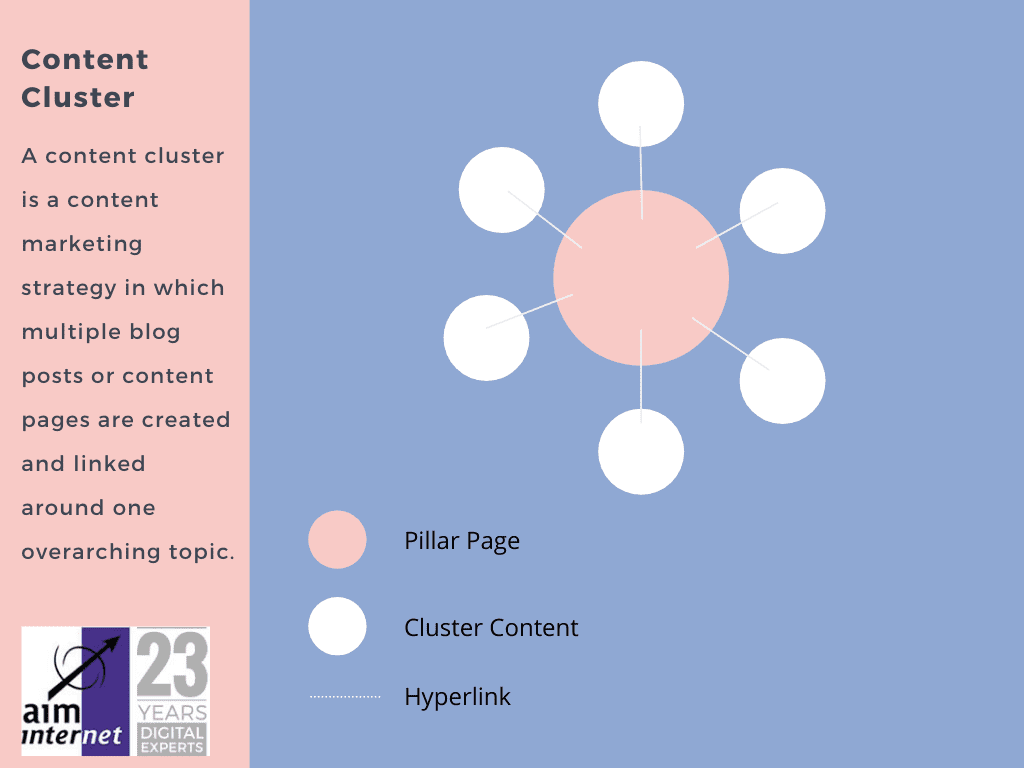When it comes to digital marketing, there are countless strategies you can use to boost your SEO – including content clusters. Here at AIM Internet, we are proud to be experts in digital marketing. So, we have put together a guide on how to create content clusters.
What Is A Content Cluster?
Let’s start with the basics, what is a content cluster?
“A content cluster is a content marketing strategy in which multiple blog posts or content pages are created and linked around one overarching topic.”
Each of these blogs or pieces of content must be linked to each other. They also need to be linked to the main pillar page. The pillar page being where we actually want visitors to your website to go to. It is essential that each part of the cluster is relative to the main subject.

Contact Us
Adding content clusters should be seen as taking your website content a step further. Great content is still a must for keeping your website ahead of the game. However, linking this content to a pillar page and creating clusters will have more effect on Google searches. Additionally, it will be more attractive to Google’s latest algorithms. When done correctly, the effect of content clusters should be a higher result in the search engine results page.
How Many Topics Should Be In A Content Cluster?
In order to create content clusters providing all content is relevant to the pillar page, there is no right or wrong answer to this question. A cluster could be as little as three or four blogs or relevant content linked to the main pillar page. Or, as many as twenty or thirty. The key principle is that each arm of the cluster must be relevant to the main pillar page. It goes without saying that the more information you provide in these clusters, the more successful your website will become.
Why Do Content Clusters Work?
Content clusters have evolved as a result of the advancement in search engine algorithms. A few years ago most searches were made using just a few keywords. These hopefully linked to the subject matter you were looking for. Now, searches are more commonly made by asking questions that are in much more detail. There are continual developments in search engine algorithms. Therefore, search engines are able to use these longer search questions to produce much more accurate results.
When you take all of this into consideration, you can see why the additional information you add to your website in clusters improves your position in search results.
Content Clusters Improve User Experience
So why should you create content clusters? The ultimate goal of all search engines such as Google, is to improve the user experience. And of course, to provide searchers with the most relevant, valuable and in depth information. Search engines are getting super smart at identifying and sending the correct search information to the person making the search. Therefore, it is even more important that any business website is fully optimised. This means the website has to be optimised to suit the search engines algorithms.
How Do Content Clusters Improve SEO?
Creating content clusters full of the most valuable relevant and in depth content on the product or service will drive the search engine towards your website. In simple terms, search engines find websites to place on the first page of a search result by identifying what it considers the main authority on the subject of the search. If you accept this methodology then you can understand why creating cluster content will enhance your chances of appearing on the first page of search results. There is no doubt that search engine developers see semantic searches as the future. They are the way to a better experience to the end user.
Our advice would be to go with the flow and try to keep ahead of the game. There is no doubt that creating clusters will make more work for you and can be time consuming. It will mean creating new content and using relevant content that you have already have. However, as with anything in life, the best things don’t come easy. Just remember, that each cluster must be relevant to the core subject and linked to the pillar page.
How To Create A Content Cluster
If you’re still reading, then you’re likely convinced that content clusters work or at least have the vision to give it a go. It is not so different from what you have been doing already, creating quality content is not something new. The change is simply ensuring it’s relevant to a particular overarching topic (the pillar page). If you enjoy creating content for your website then this is not such a difficult concept to grasp. When you start to create your content cluster it is important to identify the main subject for your pillar page. Assuming that this is a product or service that you either sell or provide already, this will not be difficult.
You should then perform a content audit to decide if it is still relevant, if it needs updating or whether it should be deleted. Then all it needs is a solid link to the pillar page. Once you have audited your existing content you should identify any gaps in it and create new content if necessary. Depending on what your business is, it is likely that you will have to create numerous clusters in order to benefit the most from it.
Take Advantage Of Existing Content
Once you have identified each topic cluster that you are going to use and have linked it to your pillar page, you need to identify the anchor text you want to target. Then, link all the content you wish to use in that group back to the pillar page. For example, if you wanted to rank for ‘battery powered lawnmowers’ you need to optimise all your marketing blogs with those keywords and link that anchor text back to the pillar page. Doing this enables the search engines to understand that each blog is part of a cluster.
Creating Your Content Cluster
Creating your content cluster will most likely be a combination of updating existing content and creating new content. You are aiming to answer all the questions that people might want answers to in and around your product or service. The aim is to fill in all the gaps by answering the who, what, where, when and why about your specific product or service. Each part of the cluster should be linked to each other as well as to the pillar page. This is so that search engines recognise that clusters have been formed. All of this linked together should tell Google and other search engines that you are an authority on the subject. As a result, it should boost your position in the search engine listings.
Related: How to Create an Internal Linking Strategy Perfect For SEO
Make The Most Of Your Hard Work
Your content cluster is complete, what next? You should take some time to try and develop relationships with other businesses within your field. Any link back from them to your site can only boost your hard work more. Any back links to your site from a recognised high authority site will gain recognition from the search engine. Therefore, it should help your business to compete in the SERPs.
Monitor The Progress
Research has shown that making use of content clusters can half the time it takes to rank for target keywords using traditional SEO methods. By keeping a close eye on your clusters you will be able to see which ones are efficient and which ones are perhaps under performing. This will give you the opportunity to add or remove content from these clusters in an effort to improve performance. As with any SEO work it is important to keep adding further relevant content using the cluster formula.
Related: Beginners Guide to SEO
AIM Internet Digital Marketing
To find out more information about creating content clusters, head to our website today. Alternatively, you can call 0207 856 0418 to speak to a member of our helpful and friendly team.
